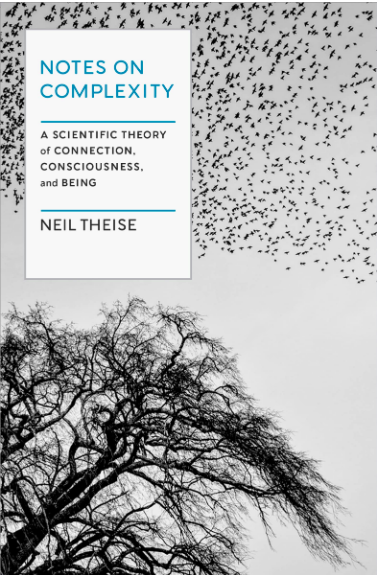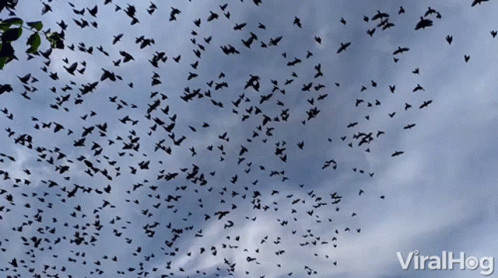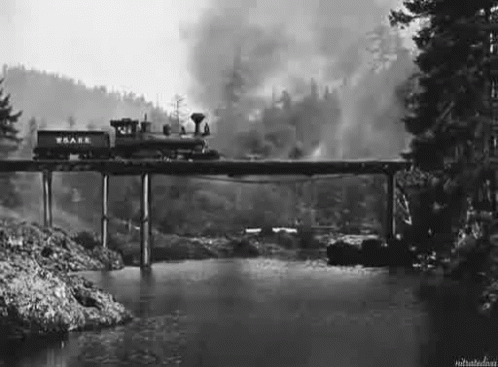Book notes. Notes on Complexity by Neil Theise (part 1)
I just finished reading Notes On Complexity (NoC) by Neil Theise. It's my favorite book on complexity science that I've read to date. This is part 1 of my notes from NoC.

Complexity science is a framework to understand and study how complex systems emerge in the world. The coolest thing about complexity science is that it applies to pretty much anything you can think about. Once you learn a bit about complexity science, you start seeing it everywhere.
But understand that the use of the word "complexity" does not refer to "complicated." When talking about complexity science or complexity theory--as explained in NoC--complexity "refers to a class of patterns of interactions: open-ended, evolving, unpredictable, yet adaptive and self-sustaining."
Complexity science explains how grand systems can bubble up from pools made up of individual agents, so long as they all follow the same set of simple rules. It's the explanation for how huge flocks of birds can fly as a big undulating unit.

It's all pretty magical, and feels a bit hippy-dippy at times. But it's also a hard science. And it's really only been studied in earnest recently.
While you can make the argument that complexity science has been around forever, it was really got going around the 1950s. And most of the work on complexity science has taken place since the founding of the Santa Fe Instititute in 1984.
Who started the work on complexity science in Santa Fe? We're talking mathematicians, physicists, and the like. There were some economists who made really big contributions, too. I guess they weren't all from the "hard sciences", but my point is that complexity science has the backing of a large and growing number of real scientists, and concerted work on these field started very recently.
emergence
The most interesting thing about life's complexity is that, everywhere you look, the whole thing is greater than the sum of its parts.
Look at consciousness. Where is it located? The more you look, the less you find it. Nobody can bottle it up or explain how it came to be. But somehow it emerges from the mess of cells, and organic materials that form humans.
A mathematical illustration of emergence is Godel's incompleteness theorems.
I'm not going to get into the weeds with what Godel had to say on this, but at a high-level he posits there are truths in math we cannot arrive at through math.
If that seems like nonsense to you, don't worry. A lot of smart folks agree also think Godel was full of it--some mathematicians included. Even if you think Godel's arguments make a lot of sense, it's still really mind-bendy stuff.
I bring Godel's argument up, because it's an example of hard math that illustrates the concept of emergence. Emergent properties are these events, behaviors and things that we cannot always predict in advance. Sometimes we just have to hang out and see what happens.
But at times it is possible to identify rules and develop frameworks for analyzing systems. Based off those rules and frameworks for specific systems, predictions with varying levels of accuracy are possible. We can also make hypotheses for what will happen if we make certain changes to a system.
Some rules apply over a wide range of domains and situations. Take the tragedy of the commons. Any cloud service or product with a free trial or any free credits will need to manage a tragedy of the commons situation.
This tells you that if you have a product that relies on user accounts to provide a product or service over the internet, and you plan on introducing a free tier, a trial period or free credits--you will need to consider how you'll handle the minority of users who will abuse your platform.
If you don't this small minority of users will negatively affect your legitimate customers, could open your company to serious regulatory risk, will place an out sized strain on your support team, and might ruin your entire product.

The good news is that on the flip side of this uncertain risk, there are certain playbooks you can run to manage abuse of a cloud service or product. While you can't provide hard numbers on how well it will work in advance, you can go to a stakeholder with reasonable confidence your solution will prevent a complete disaster. And it's all based on complexity science.
complexity science and edge-cases
The rules and frameworks of emergent behavior can also explain really bizarre outliers, like the famous man-eating lions of Tsavo. This edge cases that arise in complex systems are emergence.

The movie about those two lions (The Ghost in the Darkness) just left me wondering why the damn things decided to eat all those people. They ate 135 people!
Did they develop a taste for human flesh? Did they want to stop construction of the railway that people were building through their habitat? Was the project cursed?
Want to satisfy your curiosity?
It was a cracked incisor that turned them into man-eaters. The skull of one of the lions that was killed had a cracked incisor that would have made the killing bite a lion uses to bring down big herd animals too painful to complete. It was too injured to take down it's regular prey. It had nothing against humans in particular, it just got hungry and then learned it could still kill and eat humans with its injury.
It started eating people, because people were the just the best thing it could eat with a toothache.
This may not sound all that special. But a lion is a complex system. The cracked incisor is an example of chaos that exists within complex systems. And eating 135 railroad workers is the novel behavior that emerged from these two lions.
one plus one = three
Individual agents and behaviors creating more than the sum of their parts comes up over and over again in complexity science. You might not realize it, but we are all familiar with examples of this already.
If you separate five people and have them work at a collective task, but do not allow them to collaborate, they will not accomplish the same amount of work as they would working as a team. In other words, teamwork makes the dream work.
This is pretty obvious to most people. It's something we all have drilled into our heads from a young age. Employers put a premium on the ability to work well with others. If a person asks you in an interview whether or not you're a team player, you say "yes" if you want the job.
Here's some more examples:
- It takes money to make money.
- Safety in numbers.
- The idea of tipping points.
one plus one = three, all over the place.
At the risk of beating a dead horse, I'm going to stay on this concept for a bit longer. It is just really astounding how often this weird math shows up everywhere we look.
Mob behavior is much different from the behavior of individuals. Network effects are recognized for their power to propel businesses into the stratosphere.
Compound interest applies forward and backward, to generational wealth, to professional achievement, and to social norms.
Put a bunch of criminals in an institution together, and they start doing more bad stuff inside wherever you keep them. And then they tend to move into more complex criminal behavior once they get out.
But it's not just psychology, sociology and economics where this rule shows up. It shows up in biology, chemistry and physics, too.
It's the firestorm, a literal tornado of fire that can skip over miles of landscape before touching down back down. It doesn't happen often, but it always does when a wildfire or a city fire passes a certain threshold. It doesn't matter if the fire rises to a certain size because we firebombed the city of Dresden during WWII or because enough coastal sage catches fire in southern California next week.
And emergent behaviors, like fire storms, are crucial phenomena to understand. As the climate continues to change, we will see more and more emergent behavior that is very destructive to humanity.
from quantum foam to e = mc2
Complexity science bridges the gap between behavior at the smallest scales, the largest scales, and everything in between. It's the missing link between quantum mechanics and the theory of relativity. Complexity is the blurriness we see between the two hardest theories humans have discovered.
But it also suggests the two theories will never be fully joined. Because complexity science recognizes both the individual agents that make up a system, and the systems as a whole. It says things are are both the sum of their parts, and this big unitary system that somehow produces more than what it's made up of.
It says I am both a bunch of tiny cells that can be studied under a microscope, and an individual consciousness that you can speak to.
using ants to illustrate rules of complexity
NoC uses ants to explain a few rules that show up in virtually every complex system.
rule #1: numbers matter.
Put enough ants together and they will self-organize into an ant colony. Some ants will dig tunnels, some make food lines, and some create cemeteries for ants that die. The more ants you put together, the more complex their colony will become. But if you reduce the ant population below a certain level, the distribution of work breaks down and not enough ants work at each task necessary for a sustainable ant colony.
Higher numbers of agents in complex systems generally produce more and more complex emergence. This is the whole network effect thing.
rule #2: interactions are local, not global.
Ant colonies don't have top down planning. There's not a head honcho ant that tells all the other ants what to do. It all comes from individual ants acting at local levels. Take an ant food line, for example.

Ants produce scent signals during activities, and other ants react to those scents. When an ant is wandering for food, it leaves a scent trail. If it runs into food, it will grab the food and return back along the scent trail it created. Along the way it leaves more scent, which strengthens the trail. This creates a stronger signal for other ants to follow.
Other ants can easily follow the same scent trail. They just walk away from the colony, in the direction of the weaker scent.
As more ants walk the trail, and return with food, the food line gets stronger and more ants walk that food line until the food is gone.
There was no ant food line planning committee. It starts with one ant laying down a scent trail, and then more and more additional ants adding to the scent trail and carrying food back to the colony.
rule #3: negative feedback loops prevail.
If every ant started walking the same scent trail on a food line, nothing else in the colony would get done, and the colony would collapse. But the scent trail degrades, and eventually disappears. This prevents every ant in the colony from doing the same thing and neglecting other important tasks.
And no ant team has to clean up old food lines when the food runs out. The scent degrades over time, until it's gone.
rule #4: the degree of randomness is key.
There are a small number of ants that always do something different than most of the other ants. When the majority of ants are hard at work on a food line, some of them are just kinda goofing off.
These are often referred to as "lazy ants" because they mostly do absolutely nothing. And they make up a huge percentage of the average colony! We're talking 40 percent of an ant colony.
But this non-work activity or laziness or whatever you want to call it is necessary for the health of the whole colony. This unpredictable behavior creates a colony that is more resilient, and able to adapt to changing needs.
When the ant colony becomes threatened, because a predator is attacking or maybe a bunch of hardworking ants were wiped out--the lazy ants spring into action. They start working.
Robust, self-organizing systems require just the right amount of low-level randomness. This is also called "quenched disorder" and the term comes from the physics world.
Examples of this are heart rate variability and it's effect on cardiovascular health. Or entropy pools that every computing systems relies on to generate random numbers that are used for critical applications. It's also the random time-interval that is triggered in a network appliance when a network collision occurs.
Low-level randomness in systems allows for exploration of what Stuart Kaufman calls "adjacent possibilities".
That lone ant you find in your kitchen is the low-level randomness of a colony that is exploring "adjacent possibilities." And it might result in a bunch of ants parading through your kitchen and into the cabinets.
But there's a not so great side of this low-level randomness, too. It means there's always a chance a system can end up in an adjacent possibility that is bad or undesirable for the system. Emergent behavior is not always a good thing.
This same low-level of randomness that usually keeps systems self-organizing and self-sustaining can leave systems vulnerable to black swan events. It's a concept popularized by Nassim Nicholas Taleb, who has written a number of beautiful books on risk management.
They are events that are very unlikely at any given point, but can have devastating consequences, and given enough opportunity to occur will almost certainly happen at some point.
Examples of this include freak waves that hit ocean-liners, sudden and unpredictable economic collapse or massive earthquakes that trigger nuclear meltdowns.
bonus nerd material on ants: the ant death spiral.
Alright, I know I'm probably explaining way more about ants than you ever wanted to know. But stick with me here.
Ants display one of the most visually arresting example of suicidal emergent behavior that I can think of in a system made up of living creatures. It's the ant death spiral.
This is one of those "nature is metal" moments. Ants can get trapped in a positive feedback loop where they just follow each other round and round, in a big spiral, until they all die.
It may seem like a stretch, but I'd argue an ant death spiral is very similar phenomena to mass suicides in cults. People don't just kill themselves in groups on a regular basis. There are specific conditions that must be met, just like there are specific conditions that must be met for an ant death spiral to form.
I'd also argue suicide is an example of emergent behavior in an individual person. It's something that's not always possible to predict in advance. Or at least at this time, we are not always able to predict it in advance. Everyone has a story of a suicide that just completely shocked everyone who knew the person. And I'd bet if you could bring that person back to life, they'd probably be shocked too.
complementarity: an unsettling duality.
Complementarity is a concept from the physics world. It's a doubling of reality. It says something you are observing can be two completely different things at the same time. And it is most famously described through the study of light.
Light is both a particle and a wave. It just depends on how you observe it. Or at least it acts that way.
Another example is the human body. The tiny salty bodies of water that we carry with us, which we carry because we evolved to bring a portion of the oceans with us when our earliest ancestors left them for dry land, are divided up by a bunch of cells.
The human body is both a single fluid body, and a collection of cells. The cells are just what sub divides the fluid from which we are formed. And what you see just depends on your perspective or the scale you are looking at a human body.
But lets take this further and make it even weirder. I mean, look at your body. Where are the boundaries between you and the rest of the world?
If you look at yourself from a human-scale perspective, it seems obvious. But the smaller perspective you take, the blurrier and messier it gets.
Most of the dust in your house is skin molecules that has flaked off your body. Are those parts of you? Oh they're not, because they are not inside your body or in some way firmly attached anymore? Are you sure really sure you're not willing to consider that you're actually a cloud of human scent and molecular debris, that orbits and trails behind a more stable body?
What about the bacteria in your stomach that makes digestion possible? It also affects which neurotransmitters are released in your brain. They can make you happy or sad or crave certain foods. They are absolutely not made of human DNA, but they are also one hundred percent part of what makes a human a human.
How about the bacteria specially adapted to live in the folds of your skin wherever you have joints? Without them, the skin around any joint that moves in your body would become cracked, break and create an open sore that will not heal properly.
The tiny folds that make up the skin around your knuckles? Those are not possible without that special bacteria that lives on the backs of your fingers. It lubricates the skin around your knuckles, and creates wonderfully articulated folds for our fingers.
But what's even more nutty, is some really smart people don't think this doubling of reality only happens at tiny quantum scales or molecular scales. Niels Bohr, a founder of quantum mechanics, suggested complentarity happens at every scale of reality.
One way to ponder this idea, is to not look at yourself as human. But to instead look at yourself as part of the entire Earth that has temporarily taken the form of a walking and talking ape. After all, we came from the Earth and when we die we'll all return to become a literal part of the Earth again. We will be soil.

Which brings us to an unsettling aspect of complexity...
spooky action at a distance
We talked about interactions in complex systems happening at the local-level. That it is in fact a rule of complexity science.
But depending on the scale of a thing, this means the local-level for a system might be particles that are light-years apart. It might mean even mean every aspect of reality interacting with everything else in our known reality. That might be a scale on which a system operates.
It just depends on the system your studying, and the scale of the system.
The other side of the complementarity coin--when talking about local interactions--are the global interactions. And what I mean by "global" is: everything in our known existence.
This is what drove Einstein nuts. It's what he called, "spooky action at a distance." It's what he meant when he insisted that, "god does not play dice."
But it's also a real phenomena that scientists have observed over and over again, for a really long time.
Reality is an exceedingly weird place. And right now your head may be filling with a wonderful cognitive dissonance. Some might even call it low-levels of randomness.
The bottom line, is you really need to consider the scale(s) of the system you're looking at. Context matters.
Another famous example of "spooky action at a distance" or this strange exception to rule #2 of complexity, is the butterfly effect.
It's the idea that the flapping wings of a single butterfly in the jungles of the Amazon can cause a hurricane in Florida. Or that if they flap a slightly different way, it might cause a tornado in Alabama, instead.
This is also the most famous example cited in chaos theory, and chaos theory is integral to complexity science.

We've covered a huge amount of material. And there's still more to come in part 2 of my notes. Part 2 is also going to get into some hippy shit, that honestly--I'm not super comfortable with. I generally get pretty nervous about things when I see I'm on the same side of the fence as Deepak Chopra, and this guy's on the back of the damn book.
Oh, and here's a link to this book I'm going over, if you want to give it a read.
Notes on Complexity: A Scientific Theory of Connection, Consciousness, and Being
If you liked this, signup for my newsletter to get part 2 of my notes on NoC. There's more, and it gets weirder.




